#The State Tretyakov Gallery
Video
Борис Кустодиев «Масленица», 1916 г. by Yulia Mi
Via Flickr:
Холст, масло; 61x123 см. Государственная Третьяковская галерея, г. Москва
0 notes
Text

Kazimir Malevič, Black Square, 1913 [Tate, London. © State Tretyakov Gallery, Moscow]
87 notes
·
View notes
Text

Vasili Pukirev. Unequal Marriage.
1862–1862. State Tretyakov Gallery, Moscow.
Unequal Marriage is a masterpiece of Vasily Pukirev (1832-1890). It is one of art history's most heartbreaking paintings. To study it, you need to keep track of the whole "abyss of little things", for every detail, because otherwise we risk missing a lot.
There are two strange figures on the canvas — old women. One stands behind the groom, the other behind the priest. Both for some reason came in wreaths, and one either in a white dress, or even in a sheet or a funeral shroud. The figure of the second bride behind the priest's back looks even more strange, because this is not according to the rules of the rite. There is nothing for guests to do next to the priest — unless, of course, they come from another world.
It turns out that there are three brides at the wedding at once. Two of them are dead and looking at the old groom. And here is the artist Vasily Pukirev! He's standing with his arms crossed in the right corner and looking at the young bride. Next to him, his friend, the artist Pyotr Shmelkov, who suggested the idea of the painting to him, looks at us and seems to be asking a question: "Do you understand what's going on?".
#Vasili Pukirev#Unequal Marriage#XIX century#State Tretyakov Gallery#Moscow#Russia#art#heartbreaking#tragic#marriage#Василий Пукирев#Неравный брак#XIX век#Государственная Третьяковская галерея#Москва#Россия#искусство
76 notes
·
View notes
Text
For #WorldLionDay 🦁:

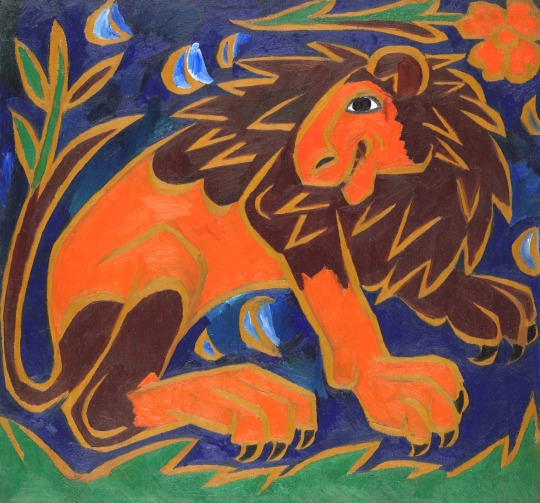
Natalia Goncharova (Russian, 1881-1962)
Lev [Lion], 1911
1. ink (study), private collection (auctioned in 2010)
2. oil on canvas (finished piece), State Tretyakov Gallery, Moscow
#Natalia Goncharova#Russian art#modern art#20th century art#1910s#illustration#painting#oil painting#ink#works on paper#lion#feline#World Lion Day#animal holiday#animals in art#private collection#State Tretyakov Gallery
29 notes
·
View notes
Text

The painting "Unequal Marriage" by Vasili Pukirev (1862) was surrounded by legend. It was said that after looking at it, older men who were planning to marry young women gave up their intent.
The painter's work is an open and courageous denunciation of the Russian society of the time. In particular, the custom was condemned (universally in vogue in the not too distant past and still present today in some countries) whereby young girls were often forced into arranged marriages with men much older than them.
The painting was highly successful and generated heated debate in the press, with its supporters praising it for representing a serious theme of modern life, unlike the usual genre scenes, which tended to be nostalgic or sentimental.
The canvas is based on an episode that actually happened and is full of details. The same painter - who was rumored to be romantically linked to the bride - depicted himself on the far right with his arms crossed, as a sign of opposition to what he is witnessing. Two old women appear half hidden in the crowd: one can be seen between the groom and the priest, the other can be seen behind the religious man: it is probable that they are the groom's deceased wives. The priest himself is hunched over and partially in shadow, perhaps to symbolize some sort of divine condemnation of this union.
However, the figure of the young, beautiful and sad bride is illuminated. Under the oblique and inquisitorial gaze of her almost-husband, she mechanically performs the ritual and keeps her gaze turned to the ground, her eyes red from crying. We can only imagine her state of mind but perhaps these verses come to our aid:
As if, once the sentence was pronounced,
frozen they were escorting you
from the luxurious prison of doubt
to the gallows, and to the dead, -
when the veil your eyes had sewn -
a creature gasped - "Pity" -
What anguish was then the most atrocious -
To die, or to be alive?
(Emily Dickinson)
📌Vasili Pukirev, The Unequal Marriage (1863)., State Tretyakov Gallery - Moskow
#Vasili Pukirev#The Unequal Marriage#State Tretyakov Gallery#Moskow#Oil painting#xix century#Russian Empire
4 notes
·
View notes
Text
I think we should joke more about Tretyakov Gallery the same way people joke about British Museum.
7 notes
·
View notes
Text
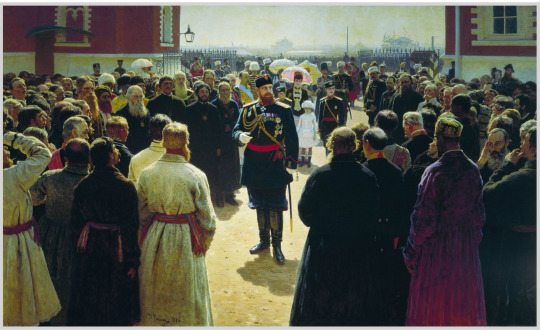
Reception of Volost elders by Emperor Alexander III in the courtyard of the Petrovsky Palace in Moscow
By Ilya Efimovich Repin (1844 - 1930); the painting is at the State Tretyakov Gallery in Moskow
Beautiful and very realistic painting by Ukranian painter Ilya Repin. When viewing the painting, you can feel that you are among the people looking at Tsar Alexander III; in the back, noticd the Empress (with a pink umbrella) with two of her children...a little girl who might be Xenia; the young man in uniform is obviously the future Tsar Nicholas II.
#russian history#imperial russia#Emperor Alexander III#Ilya Repin#State Tretyakov Gallery#russian art
7 notes
·
View notes
Text

Evgeny Askerovich Izmailov (born 1939) "A Figure and Three Horses". On the back "Bouquet". 1985.
Canvas, tempera, 60×50 cm.
There are author's signatures in the lower right corner.
Origin: the property of the author.
Painter, graphic artist. He studied at the Moscow Secondary Art School in Lavrushinsky Lane (1953–1959), at the Moscow State Institute named after C I. Surikova (1959–1964) - first at the Faculty of Painting, and then at the theater. In 1964-1969, as an author and artist, he published several children's books. In 1969-1979, he experimented a lot with the form, material, format, genre of his works. He was engaged in etching, making voluminous things from wood and paper. He illustrated two books in the etching technique. In 1990-1995 he worked in Germany, England, France. In addition to easel things, he did work in volume, advertising projects, wall paintings. In the 1970s, he participated in apartment exhibitions, in the 1980s - in the expositions of the G20 on Malaya Gruzinskaya. A participant of the famous exhibition of uncensored art at VDNH (1975), Evgeny Izmailov subsequently naturally became one of the participants of the landmark project "Other Art", held in 1990-1991 at the Tretyakov Gallery. Since the early 1990s, Izmailov has worked a lot and exhibited in Western Europe. The artist's works are stored in the GTG, State Art Institute of Art named after A.S. Pushkin, Tomsk City Museum, Berlin City Museum and Dresden Gallery (Germany), as well as in private collections in Moscow, St. Petersburg, Vienna, Paris, Toronto, Seattle, Bangkok, Cologne, Hamburg, New York.
Litfund
85 notes
·
View notes
Text
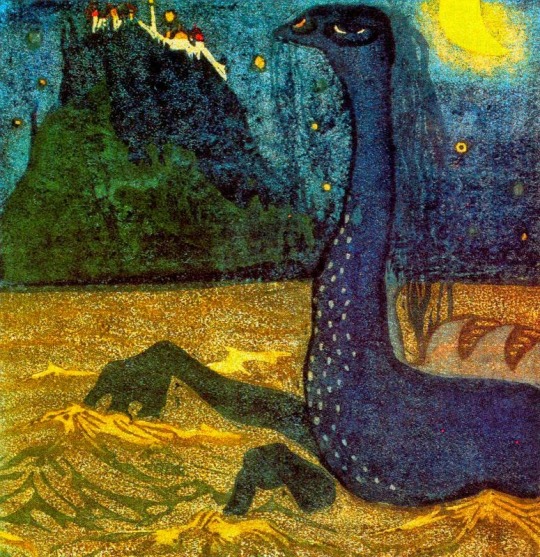
Wassily Kandinsky, Moonlight Night, 1907
Moscow, The State Tretyakov Gallery
256 notes
·
View notes
Text

Vladimir Lukich Borovikovsky (Russian, 1757-1825)
Our Lady, ca.1814-15
State Tretyakov Gallery, Moscow
#Vladimir Lukich Borovikovsky#Russian art#russia#russian#our lady#1800s#art#fine art#european art#classical art#europe#european#oil painting#fine arts#europa#mediterranean#painting#artwork#christian art#christian#christianity#christentum#catholic#bible#catholicism#western civilization#catholic art
290 notes
·
View notes
Text
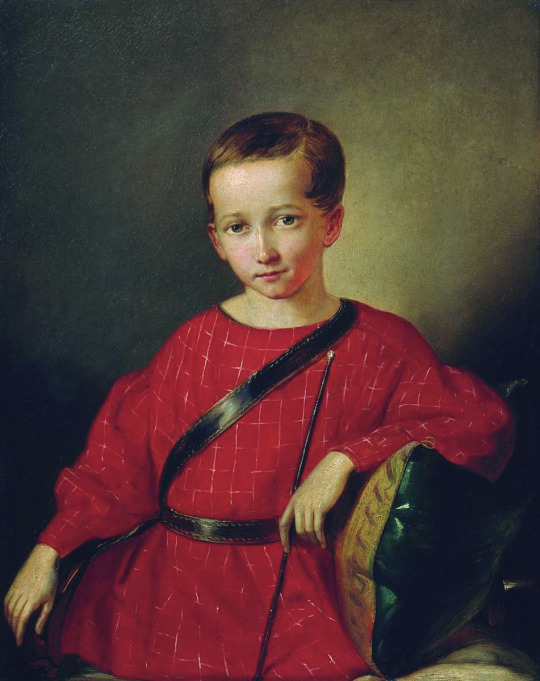
1845 Petr Zabolotskiy - Portrait of a boy in red
(State Tretyakov Gallery)
72 notes
·
View notes
Text

A house in the mountains, ca. 1912, State Tretyakov Gallery, Moscow - by Alexej von Jawlensky (1864 – 1941), Russian
23 notes
·
View notes
Text

Mikhail Nesterov, 'Portrait of artists P. D. and A. D. Korinykh' (1930), Canvas, oil. 126 x 126 cm., State Tretyakov Gallery, Moscow.
29 notes
·
View notes
Text

Vasily Tropinin. Self-Portrait with Brushes and a Palette Against a Window Facing the Kremlin.
1846. State Tretyakov Gallery, Moscow.
The outstanding Russian painter Vasily Andreevich Tropinin was born a serf peasant and until 1823 he was a serf of Count A.S. Minikh, and later Count I.I. Morkov. He got his freedom only at the age of 47, when he already became a famous artist. Having gained the long-awaited freedom, Tropinin decided to settle in Moscow, where he became one of the most respected artists among the residents of the city. His paintings are painted in the spirit of realism with notes of romanticism.
#Vasily Tropinin#Self-Portrait with Brushes and a Palette Against a Window Facing the Kremlin#XIX century#art#Russia#Moscow#State Tretyakov Gallery#Romanticism#portrait#Василий Тропинин#XIX век#искусство#Автопортрет на фоне окна с видом на Кремль#Государственная Третьяковская галерея#портрет#романтизм#Москва#Россия#живопись
0 notes
Text
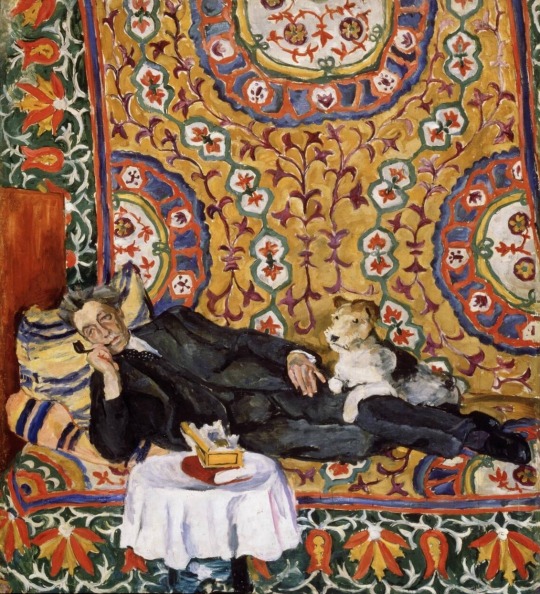
Pyotr Konchalovsky (1876–1956)
"Portrait of the theatre director Vsevolod Meyerhold (1874–1940)", 1938
State Tretyakov Gallery, Moscow
Meyerhold was a significant figure in symbolist, constructivist, and futurist circles. This portrait was painted about a year before his arrest by the NKVD and his wife's murder. He was tortured and subsequently shot by firing squad in 1940.
48 notes
·
View notes
Text

Boris Kustodiev (Russian, 1878–1927) • Inside a Moscow Tavern • 1916 • State Tretyakov Gallery, Moscow
#boris kustodiev#art#paintings of interiors#fine art#painting#making room blog#russian artist#genre scene#early 20th century russian painting#russian impressionism#impressionism#historical painting#art history#oil on canvas#art appreciation#cats in art
33 notes
·
View notes